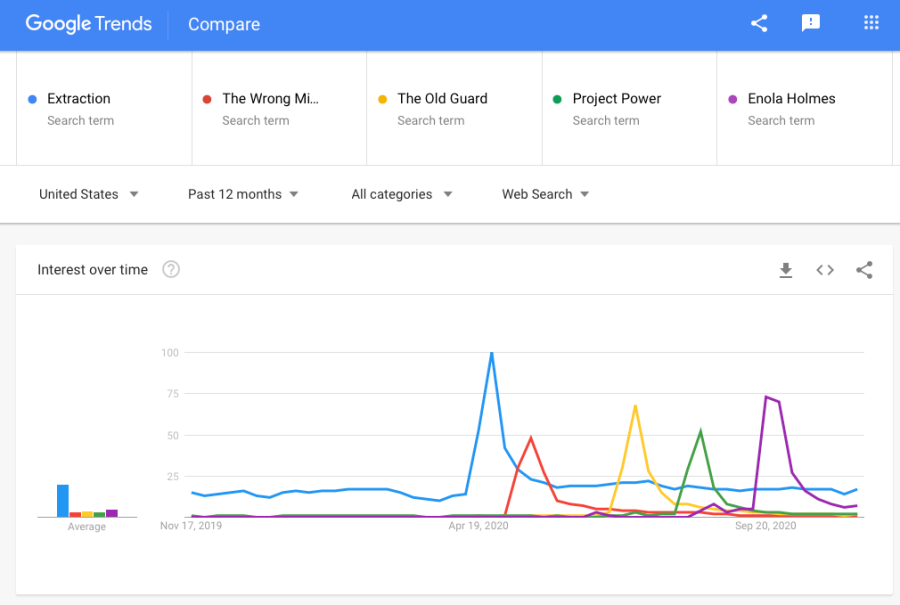In December of 2018, Netflix let loose with their first datecdote™. They told us this…
Took off my blindfold this morning to discover that 45,037,125 Netflix accounts have already watched Bird Box — best first 7 days ever for a Netflix film! pic.twitter.com/uorU3cSzHR
— NetflixFilm (@NetflixFilm) December 28, 2018
But they went further! By their earnings report, they started telling us how many folks were watching their films in the first 28 days. Including an updated number for Bird Box of 80 millions subscribers watching 70%. Which allowed me to draw this conclusion:
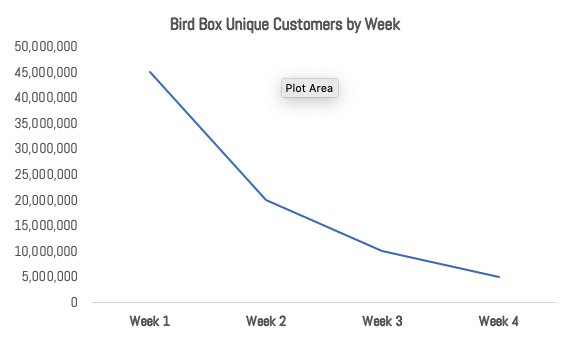
As I wrote at the time, “the decay is real!”
Specifically, films that premiere on Netflix tend to have a significant chunk of their viewership in the first week or weekend. This is a binge-release wide phenomenon. Yet I had trouble proving the case. The other main piece of data I use is Google Trends data. But Google Trends isn’t viewership, just interest. I needed another data source (or leak) to prove it.
(Prove it to you, by the way. Not me. I know it’s true from personal experience at a major streamer. But non-disclosure agreements mean I can’t use that data.)
The decay of films has direct ramifications on the streaming wars. The steeper a film decays, the harder it is to monetize long term. So knowing how shows and films perform over time is important for the streaming wars. To show just one example, my Mulan analysis relied on forecasting its decay over time.
So I had a pretty strong hypothesis but couldn’t prove it beyond one example. Until today!
See Nielsen has been releasing weekly top ten lists of the most streamed shows. By total minutes viewed. They provided my their data going back to April of 2020. What I can do now is analyze movie performance to see if my hypothesis bears out. And it does.
But let’s start with what this data is. I complain bitterly that most articles don’t lay this out, so here you go.
Who – Streaming customers
What – Total hours viewed (Nielsen provides million minutes and I divide by 60)
What (platform) – Any service
Where – In the United States
When – From March 30th to October 18th 2020
When (time period) – Measured Monday to Sunday.
How (did I get it) – Nielsen provided.
This data set ended up being 29 weeks of data, or 290 data points. Separating out the films gave me 17 unique films that ended up on the streaming top ten, 16 Netflix and one Disney. Of the 17 films, only six had two weeks of data. So I plotted the decay and got this:
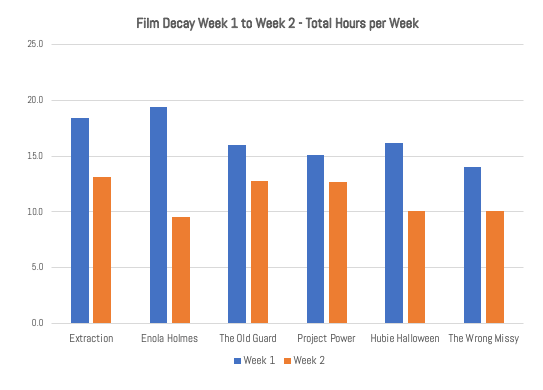 Hypothesis failed! Look at Extraction or Old Guard. They only decayed at roughly the rate of 28% and 20% respectively.
Hypothesis failed! Look at Extraction or Old Guard. They only decayed at roughly the rate of 28% and 20% respectively.
Ah, but apples-to-apples, am I right? Nielsen starts their data on Mondays. And not all Netflix films were released on the same day of the week. Historically, Netflix released big films on Fridays, but started moving some films to Wednesday. Like Enola Holmes. So let’s account for this and change our metric to hours per day (millions):
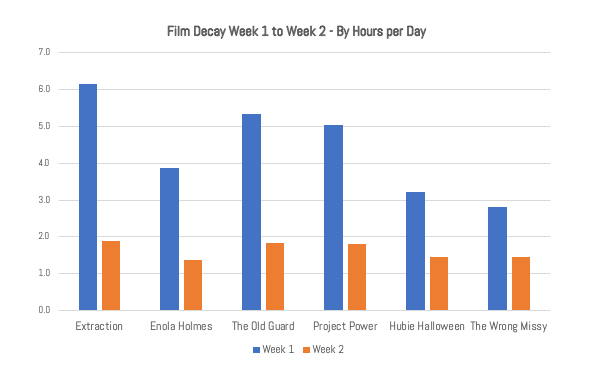 There you go! See, the decay is real! (69 and 65% decay for Extraction and The Old Guard.)
There you go! See, the decay is real! (69 and 65% decay for Extraction and The Old Guard.)
But we can go one final step further. See, no Netflix film made it in the top ten for three weeks in a row. (With the caveat that we won’t know Hubie Halloween results until next week. Maybe it breaks the trend due to its theme.) This means we know that at the very least the lowest rated film in the top ten is the ceiling for our five films decay. That gives us this chart:
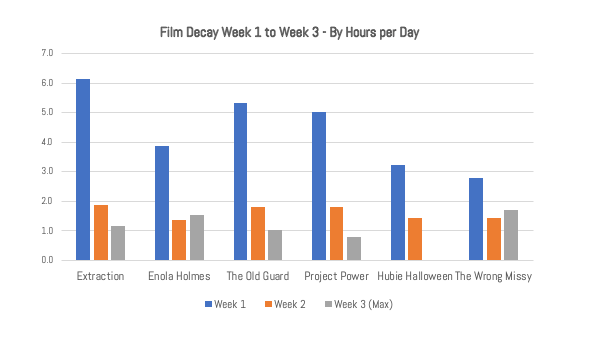 To iterate, the week 3 numbers is the maximum number of hours per day a film could have received based on the number 10 film in Nielsen’s streaming rates. The actual number could be even lower. So I’d say Extraction, The Old Guard and Project Power (all Friday releases) are the best look at what decay for a given title looks on Netflix week-to-week. (I would bet lots of money Enola Holmes and The Wrong Missy lost viewership into week 3.)
To iterate, the week 3 numbers is the maximum number of hours per day a film could have received based on the number 10 film in Nielsen’s streaming rates. The actual number could be even lower. So I’d say Extraction, The Old Guard and Project Power (all Friday releases) are the best look at what decay for a given title looks on Netflix week-to-week. (I would bet lots of money Enola Holmes and The Wrong Missy lost viewership into week 3.)
In total, this makes 9 films that show this sharp decay. The six above, plus Bird Box (see opening) and The Irishman and Murder Mystery, which are the only two other films that Netflix confirmed the opening weekend and 28 day totals. (Murder Mystery had 45 million subscribers opening weeekend and 73 million at 28 days, at 70% completion. Irishman had 26 million opening week at 70% completion into 47 million 28 days.)
Now that I have my film data set cleaned up, there are a lot more questions to answer. What type of films made the top ten list? What does this say about Netflix’s strategy? What about the correlation of US Nielsen minutes viewed to Netflix global 2 minute datecdotes? What films made Nielsen’s list but not Netflix’s datecdote list? Those are all great questions, but will come in future articles.
Thanks to Nielsen for providing the data. If you’re an analytics company that wants to give me data, send me an email.
(By the way, if you wanted to know the Google Trends look of those films, here you go:
